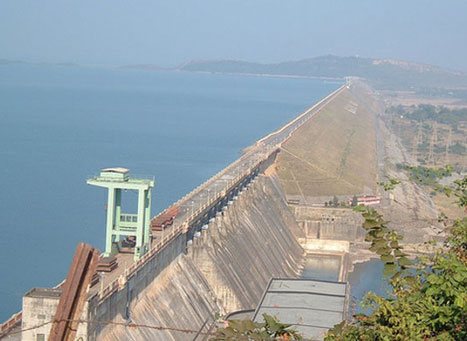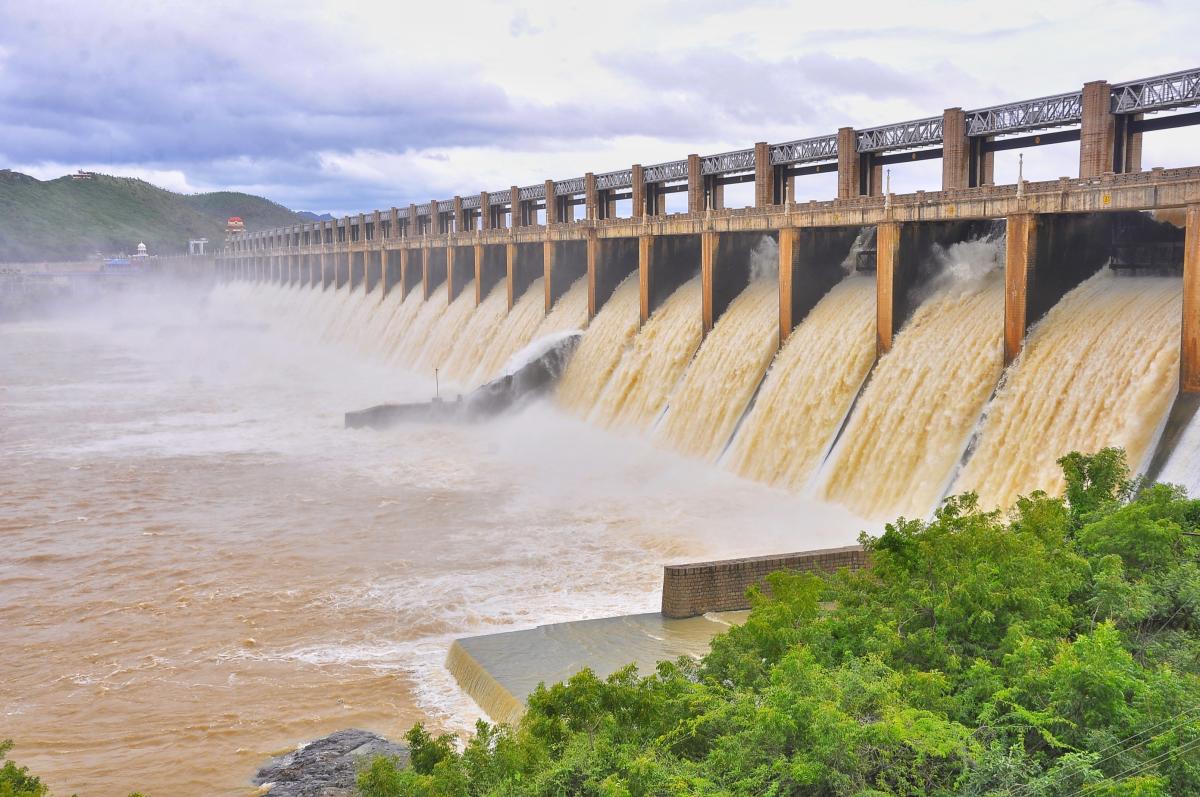The List of major dams In India is provided here in detail. Dams in India play a significant role in pursuit of sustainable development.

List of Major Dams in India: Dams in India play a significant role in India’s pursuit of sustainable development and resource management. As one of the world’s most populous nations, India faces the dual challenge of meeting the growing energy demands of its people while ensuring efficient water management for agricultural and industrial purposes. Dams provide a crucial solution to these challenges, serving as reservoirs of water and sources of hydroelectric power. In this article, we will have a look at the List of Major Dams in India.
India is home to numerous dams, which play a crucial role in the country’s water management, irrigation, hydroelectric power generation, and flood control. In this article, we will have a look at the Major Dams in India.
Dams serve as barriers that impede the natural flow of water, leading to the formation of reservoirs. One of the primary purposes of constructing dams is to harness the power of water to generate electricity, a form of energy called hydroelectricity.
In addition to electricity generation, the reservoirs created by dams offer various benefits. They help control and mitigate the occurrence of floods by regulating the flow of water. These reservoirs also serve as vital water sources for activities like irrigation, supplying water for human consumption, industrial usage, aquaculture, and facilitating navigation along waterways. The storage capacity provided by dams ensures a steady and reliable water supply, supporting diverse sectors and contributing to the socio-economic development of the regions they serve.
Following are the types of Dams in India:
1. Arch Dam: An arch dam is a curved concrete structure designed to withstand the pressure of water by utilizing the arch shape. It is suitable for narrow canyons or gorges with stable rock walls.
2. Gravity Dam: Gravity dams are made of concrete or stone masonry and rely on their weight to resist the force of water. Each section of the dam is self-supporting and stable.
3. Arch-Gravity Dam: This type of dam combines the features of an arch dam and a gravity dam. It curves upstream, directing water pressure against the canyon walls and reducing lateral forces on the dam.
4. Barrages: Barrages are low-head diversion dams equipped with large gates to control the flow of water. They are used to stabilize river water levels upstream for irrigation and other purposes.
5. Embankment Dams: An embankment dam is a large artificial structure built by compacting soil, sand, clay, or rock. It has a semi-pervious surface and a dense, impermeable core.
6. Rock-Fill Dams: Rock-fill dams are constructed by compacting granular earth with large particles. The rocks provide stability and drainage capabilities.
7. Concrete-face Rock-Fill Dams: These dams combine rock-fill materials with concrete slabs on the upstream face. The concrete layer prevents leakage and adds structural strength.
8. Earth-Fill Dams: Earth-fill dams, also known as earthen dams, are constructed by compacting well-compacted earth materials. They may include a drain layer to collect seepage water.
Dams play a crucial role in India’s water management and development. They have significant benefits, including:
1. Water Supply: Major dams provide a reliable source of water for domestic, industrial, and irrigation purposes. The reservoirs store water during the monsoon season and release it during dry periods, ensuring a steady supply for various needs.
2. Hydroelectric Power: Many of the major dams in India are equipped with hydroelectric power stations. These dams harness the power of flowing water to generate electricity, contributing to the country’s energy needs and reducing dependence on fossil fuels.
3. River Navigation: Dams facilitate river navigation by regulating water flow and maintaining navigable channels. They improve transportation, allowing boats and ships to navigate inland waterways efficiently, enhancing connectivity and trade.
4. Recreation: The reservoirs created by major dams offer recreational opportunities such as fishing and boating. These water bodies serve as popular tourist destinations, attracting visitors and boosting local economies.
5. Flood Control: Dams play a vital role in flood control by storing excess water during heavy rainfall and releasing it gradually. This helps prevent sudden surges and reduces the risk of flooding in downstream areas, safeguarding lives and property.
India is home to numerous major dams, each contributing to water resource management, electricity generation, and overall development. These dams have transformed the landscape and provided various benefits to the people and the environment.
Here is a list of major dams in India, along with a brief description of their history and importance:
1. Nagarjuna Sagar Dam (Andhra Pradesh): Built on the Krishna River, it is one of the largest dams in India. It was constructed in 1967 and plays a crucial role in irrigation, power generation, and flood control.
2. Sardar Sarovar Dam (Gujarat): Located on the Narmada River, this dam is a major source of water for irrigation and drinking purposes in Gujarat. It has been a subject of controversy due to its environmental and social impact on the displaced communities.

3. Bhakra Dam (Himachal Pradesh): Constructed on the Sutlej River, Bhakra Dam is one of the highest gravity dams in the world. It provides irrigation water to several states and generates hydroelectric power.

4. Idukki Dam (Kerala): Situated in the high ranges of the Western Ghats, Idukki Dam is a double curvature arch dam. It plays a significant role in the production of hydroelectric power and water storage for irrigation.

5. Tehri Dam (Uttarakhand): Built on the Bhagirathi River, Tehri Dam is one of the tallest dams in India. It provides water for irrigation, generates hydroelectric power, and serves as a reservoir for drinking water supply.

6. Hirakud Dam (Odisha): Constructed on the Mahanadi River, Hirakud Dam is the longest major earthen dam in the world. It helps in flood control, irrigation, power generation, and navigation.

7. Koyna Dam (Maharashtra): Located in the Koyna Nagar of Maharashtra, Koyna Dam is a crucial hydroelectric project. It is built on the Koyna River and has contributed significantly to power generation in the state.

8. Mettur Dam (Tamil Nadu): Situated on the Cauvery River, Mettur Dam is a vital water resource for irrigation in the delta region of Tamil Nadu. It also supplies drinking water to nearby towns and generates hydroelectric power.

9. Rihand Dam (Uttar Pradesh): Constructed on the Rihand River, Rihand Dam is the largest dam in Uttar Pradesh. It provides irrigation water, generates hydroelectric power, and helps regulate water flow in the region.

10. Indira Sagar Dam (Madhya Pradesh): Located on the Narmada River, Indira Sagar Dam is one of the largest reservoirs in India. It supports irrigation, power generation, and provides drinking water to nearby areas.
These are just a few examples of major dams in India. Each dam has its own unique history and serves various purposes such as irrigation, power generation, flood control, and water storage, contributing significantly to the development and progress of the respective regions.
India is home to numerous dams that play a crucial role in irrigation, water supply, hydroelectric power generation, and flood control. The country’s diverse topography has facilitated the construction of dams across its states, contributing significantly to agricultural and industrial growth. Below is a comprehensive state-wise list of major dams in India:
| State | Major Dams |
|---|---|
| Andhra Pradesh | Nagarjuna Sagar Dam, Srisailam Dam, Pulichintala Dam, Somasila Dam, Prakasam Barrage |
| Arunachal Pradesh | Subansiri Lower Dam, Dibang Dam, Ranganadi Dam, Kameng Dam |
| Assam | Karbi Langpi Dam, Kopili Dam, Subansiri Dam |
| Bihar | Koshi Barrage, Farakka Barrage, Supaul Barrage, Bagmati Barrage |
| Chhattisgarh | Indravati Dam, Hasdeo Bango Dam, Dudhawa Dam, Murrum Silli Dam |
| Gujarat | Sardar Sarovar Dam, Ukai Dam, Dantiwada Dam, Kadana Dam, Dharoi Dam |
| Himachal Pradesh | Bhakra Dam, Pandoh Dam, Chamera Dam, Nathpa Jhakri Dam, Pong Dam |
| Jammu and Kashmir | Baglihar Dam, Salal Dam, Uri-II Dam, Dulhasti Dam |
| Karnataka | Almatti Dam, Tungabhadra Dam, Krishnarajasagar Dam, Linganamakki Dam, Supa Dam |
| Kerala | Idukki Dam, Mullaperiyar Dam, Malampuzha Dam, Periyar Dam |
| Madhya Pradesh | Bargi Dam, Indira Sagar Dam, Omkareshwar Dam, Tawa Dam, Gandhi Sagar Dam |
| Maharashtra | Koyna Dam, Jayakwadi Dam, Bhandardara Dam, Wilson Dam, Vaitarna Dam |
| Odisha | Hirakud Dam, Rengali Dam, Upper Kolab Dam, Mandira Dam, Balimela Dam |
| Punjab | Bhakra Dam, Ranjit Sagar Dam, Harike Barrage, Hussainiwala Barrage |
| Rajasthan | Rana Pratap Sagar Dam, Jawai Dam, Mahi Dam, Bisalpur Dam |
| Tamil Nadu | Mettur Dam, Mullaperiyar Dam, Vaigai Dam, Parambikulam Aliyar Project (PAP) Dam |
| Telangana | Nagarjuna Sagar Dam, Srisailam Dam, Sriram Sagar Dam, Singur Dam, Lower Manair Dam |
| Uttar Pradesh | Tehri Dam, Rihand Dam, Matatila Dam, Kanpur Barrage, Obra Dam |
| Uttarakhand | Tehri Dam, Ramganga Dam, Dharasu Dam, Maneri Dam |
| West Bengal | Farakka Barrage, Maithon Dam, Panchet Dam, Tilaiya Dam, Konar Dam |
APJ Abdul Kalam Biography, Birth, Full Name, Awards, Death
Oommen Chandy Biography, Death, Funeral, Age, Family, Religion
India presently has a total of 5,334 dams, among which 447 are the major ones.
India's top 10 biggest dams are Tehri, Bhakra Nangal, Sardar Sarovar, Hirakud, Nagarjuna Sagar, Indira Sagar, Krishnarajasagar, Tungabhadra, Rihand, and Idukki Arch Dam.
Bhakra dam, situated on the Sutlej River in Himachal Pradesh, is a substantial gravity dam. It holds the distinction of being India's largest dam and the second largest in Asia, towering at a height of 225 meters. The reservoir it creates, named "Gobind Sagar Lake," ranks as India's second largest reservoir, following the Indira Sagar dam.
The Kallanai (also known as Grand Anicut) is considered to be the oldest dam in India. It is located on the Kaveri River in the state of Tamil Nadu.

<div class="new-fform">
</div>